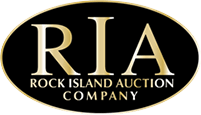Lot 1421: North & Cheney U.S. Model 1799 Flintlock Pistol
Incredibly Rare First Contract North & Cheney U.S. Model 1799 Flintlock Pistol
Auction Location: Rock Island, IL
Auction Date: September 7, 2019
Lot 1421: North & Cheney U.S. Model 1799 Flintlock Pistol
Incredibly Rare First Contract North & Cheney U.S. Model 1799 Flintlock Pistol
Auction Location: Rock Island, IL
Auction Date: September 7, 2019
Incredibly Rare First Contract North & Cheney U.S. Model 1799 Flintlock Pistol
U.S. Model 1799 flintlock pistols are among the scarcest, most important, and highly prized of all antique American firearms and are certainly the most desirable of all U.S. martial flintlock pistols. This specific example, number 175, is photographed and described on the top of page 231 in "The William Locke Collection", once part of his famous collection. In "Historic Pistols: The American Martial Flintlock, 1760-1845" by Smith and Bitter, the authors note that only seven of these First Contract pistols and nineteen Second Contract pistols were known to survive. The Model 1799 was the first official pistol adopted by the United States military and was based heavily on the French Model 1777 used by French forces during the American Revolution. They are very distinctive owing to their brass frame with integral lock similar to the earlier "Queen Anne" pistol. The Model 1799 differs by having a shorter barrel length, rounder breech, and additional barrel screw on the bottom of the frame at the front. It is the only U.S. martial pistol built in this non-conventional fashion. Only 2,000 were manufactured by Simeon North and his brother-in-law Elisha Cheney, a clock maker, in Berlin, Connecticut, in 1799-1801 in two contracts. Of those, only 500 were First Contract pistols which are identified by the presence of the makers' first initials as can be seen on this pistol. North also manufactured many of the later pattern U.S. martial weapons over slightly more than half a century of arms making and is considered the "first official pistol maker" to the U.S. government as he manufactured several of the first official U.S. models. The few other makers who produced pistols on contract with the federal government did not do so in as significant of quantities nor based on the recognized "official" patterns. The barrel is smoothbore and has no sights. The top of the barrel is stamped "US" ahead of the tang and has "V/P" to the left, and "S. NORTH & E CHENEY BERLIN" is stamped in an arch on the bottom of the frame. The serial number, "175," is on the bottom of the barrel, left side of the breech, and inside of the action, and several of the screws and other parts have double dash line assembly markings. A removable collection marking "JF 206" in "Whiteout" is on the trigger guard bow. Also included are a copy of "An Exhibit of 19th Century U.S. Military Sidearms" by the Ohio Gun Collectors Association from the 1992 NRA Convention in Salt Lake City where this gun was displayed, copy of "A Report to the Owners of the Surviving North & Cheney Pistols on the Present Ownership, Whereabouts, and Condition of the Surviving North & Cheney Pistols" compiled by James Frisbie, a July 2013 letter to Frisbie from James M. Wertenberger detailing this pistol including that original are believed to have been used by Locke in the reconversion of the pistol, and a letter from Frisbie to Wertenberger thanking him for the information and noting that the information will "add considerably to the value of the gun. . ."
Fine as reconverted to flintlock configuration (reportedly using original parts, see above) with a mottled gray patina and mild pitting on the iron, attractive aged patina on the brass, general scrapes and dings, and mild overall wear. The refinished replacement stock is good and slightly undersized and has some light scratches and dings. The half-cock is not functioning; otherwise, it is mechanically fine. We have had the privilege of selling two Second Contract pistols, but this is the first time we have been able to offer a First Contract U.S. Model 1799 pistol. Chances to acquire this historic model are fleeting. We might not see another for many years to come!
Customer Product Questions
There are currently no customer product questions on this lot
